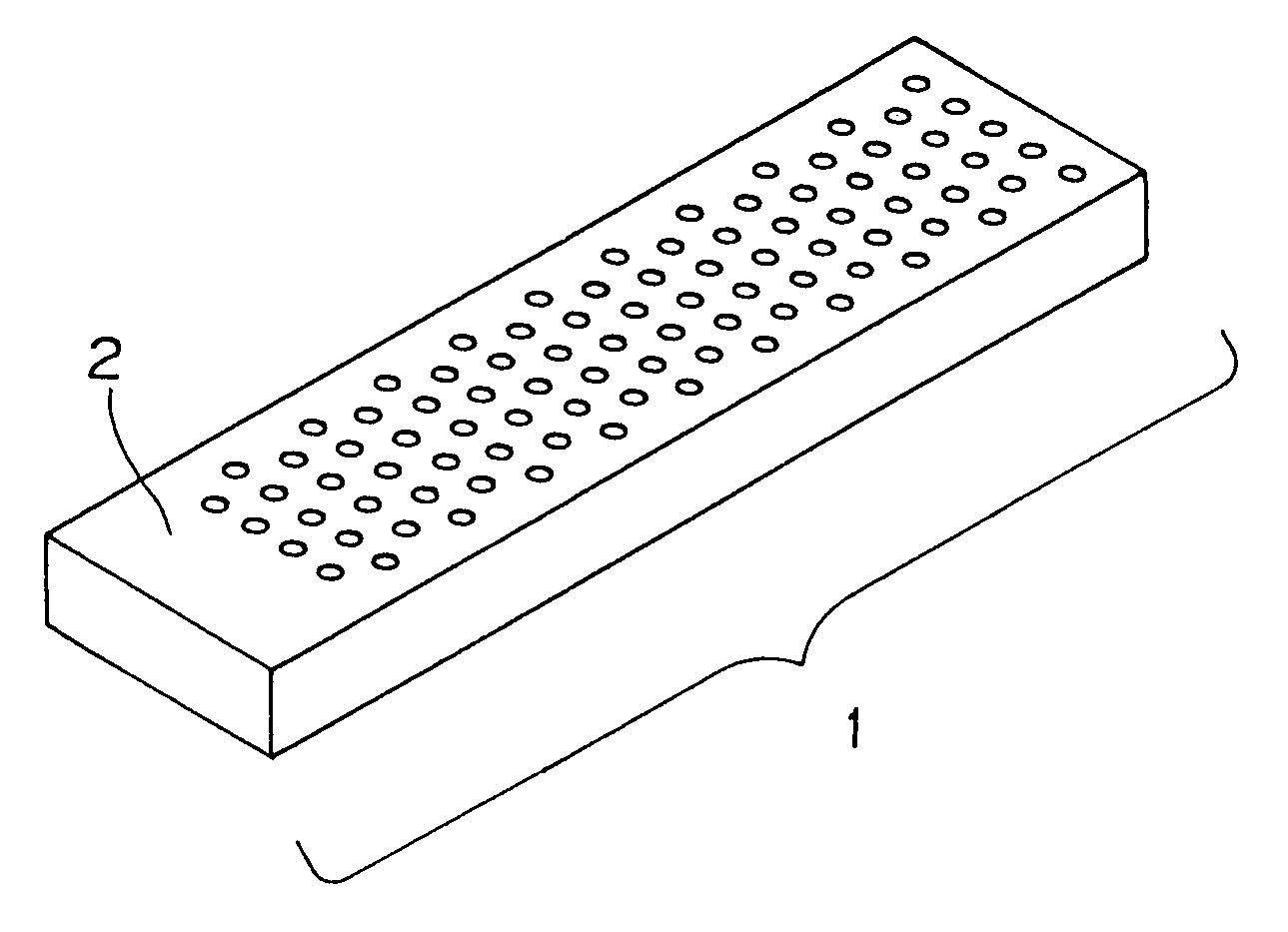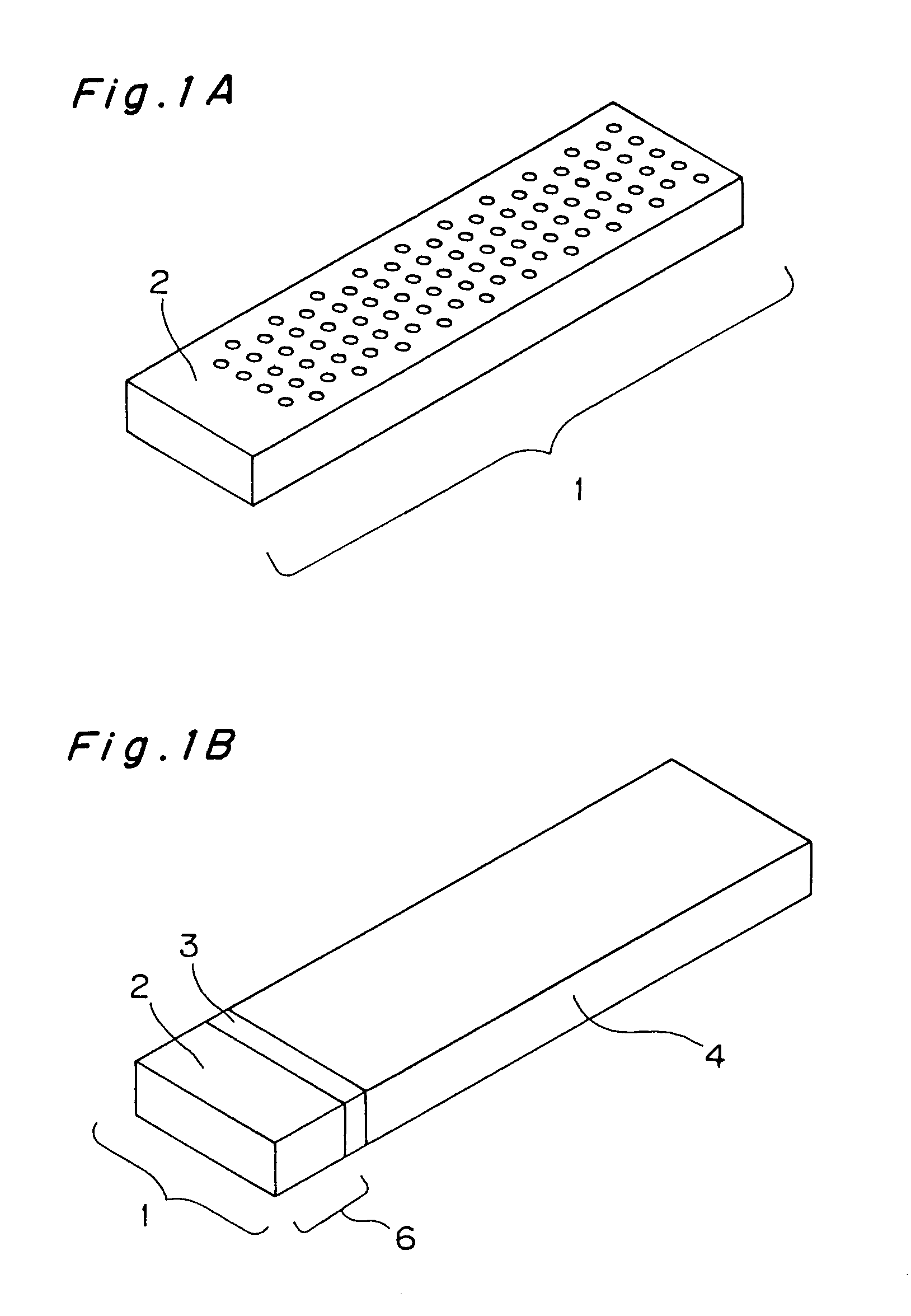Electrolytic capacitor and method of producing the same
a technology of electrolytic capacitors and capacitor electrodes, which is applied in the direction of electrolytic capacitors, capacitor electrodes, solid-state devices, etc., can solve the problems of long polymerization time, difficult to grow a conductive polymer layer having a uniform and sufficient thickness, and prolonging the operating time of polymerization, etc., to achieve the effect of repairing partial damag
- Summary
- Abstract
- Description
- Claims
- Application Information
AI Technical Summary
Benefits of technology
Problems solved by technology
Method used
Image
Examples
embodiment 1
[0074]In the invention, the conductive polymer layer 4 is formed by a method of subjecting the above-mentioned monomer to electrolytically oxidative polymerization. In the method, an electrolyzing electrode is utilized, which is formed previously on one side surface of the anode of the valve metal foil 1.
[0075]This embodiment can use a sheet or foil of metal, such as nickel, as a electrolyzing electrode. Other metals and non-organic substances may also be used if they can act as a positive electrode in the monomer solution for electrolyzing with no corrosion and anodic passivation.
[0076]The electrolyzing electrode and the valve metal, being attached in contact to each other, is immersed into the monomer solution. A current is supplied to the electrolyzing electrode (positive) attached on the valve metal foil and another electrode disposed in the solution so that an electrolytic polymerization reaction starts on the surface of the electrolyzing electrode by anodizing reaction. When t...
embodiment 2
[0097]In the electrolytic capacitor of the present embodiment, a cathode-side conductive polymer layer 5 is formed, as part of a cathode layer, in advance on the dielectric layer 3 on one side surface of the anode valve metal foil 1, as shown in FIG. 5. The electrolytically-formed conductive polymer layer 4, which composes the rest of the cathode layer, a substantial cathode, covers the almost entire surface of the dielectric layer 3, penetrating the through holes 20 to fill their interiors. The cathode-side conductive polymer layer 5 is electrically connected to the electrolytically-formed conductive polymer layer 4, so that both the two conductive polymer layers 4 and 5 are a cathode layer to produce an electrolytic capacitor.
[0098]This electrolytic capacitor is formed by interposing the dielectric layer 3 between the anode valve metal foil 1 and the electrolytically-formed conductive polymer layer 4. This electrolytically-formed conductive polymer layer 4 may be formed uniformly ...
embodiment 3
[0118]In the present embodiment, a conductive polymer layer 5 is formed on a dielectric layer 3 on one side surface of an anode valve metal foil 1 as shown in FIG. 9.
[0119]Furthermore, an electrolytically-formed conductive polymer layer 4 covers the almost entire surface of the dielectric layer 3, and penetrates the through holes 20 in the metal foil 1. A cathode electric collector 13, made of a metal sheet, is electrically connected to the electrolytically-formed conductive polymer layer 4 via the cathode-side conductive polymer layer 5, thereby forming an electrolytic capacitor. This electrolytically-formed conductive polymer layer 4 is formed in a wide area on the dielectric layer 3 and functions as the cathode, whereby the capacitance of the electrolytic capacitor can be raised sufficiently.
[0120]Furthermore, the cathode electric collector 13 electrically connected to the electrolytically-formed conductive polymer layer 4 is formed and used for lead connection.
[0121]Two leads fo...
PUM
| Property | Measurement | Unit |
|---|---|---|
| inner diameter | aaaaa | aaaaa |
| width | aaaaa | aaaaa |
| thickness | aaaaa | aaaaa |
Abstract
Description
Claims
Application Information
 Login to View More
Login to View More - R&D
- Intellectual Property
- Life Sciences
- Materials
- Tech Scout
- Unparalleled Data Quality
- Higher Quality Content
- 60% Fewer Hallucinations
Browse by: Latest US Patents, China's latest patents, Technical Efficacy Thesaurus, Application Domain, Technology Topic, Popular Technical Reports.
© 2025 PatSnap. All rights reserved.Legal|Privacy policy|Modern Slavery Act Transparency Statement|Sitemap|About US| Contact US: help@patsnap.com



